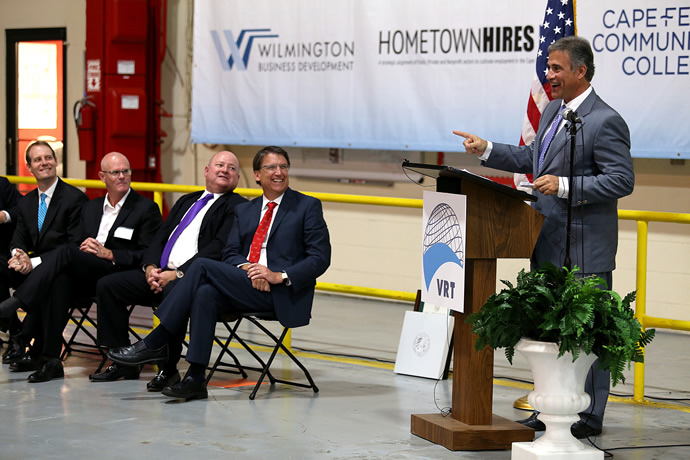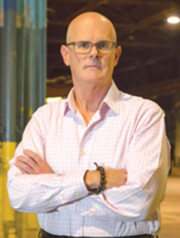
A 130-year-old site in North Carolina where cranes big enough to lift derailed railcars were once made now is on the rebound itself. The manufacture of safer tank railcars in the case of derailments is the reason why.
In November, Vertex Rail Technologies, LLC, a manufacturer of railroad tank cars, announced it would occupy the former Terex Crane facility near the Port of Wilmington, N.C., in order to make a new breed of safer tank car, pending the release of a final rule and regulations on their design by the federal government.
That new rule was announced in early May by US Transportation Secretary Anthony Foxx and Canadian Minister of Transport Lisa Raitt. It came earlier than some expected, in part to stem increasing concerns about accidents and fires involving tankers full of crude oil, the worst example being the fireball in the center of Lac-Mégantic, Quebec, that killed 47 people in July 2013. Other, less horrific accidents involving tank cars have occurred throughout the US in recent months.
The specter of such mishaps might naturally be expected to slow things down for the railcar industry, especially as regulations tighten. But not for a company with a solution. Vertex plans to invest $60 million at the Wilmington site, where it will employ over 1,300 workers across two shifts, with an average salary of $40,000 and an annual capacity of 4,500 railcars.
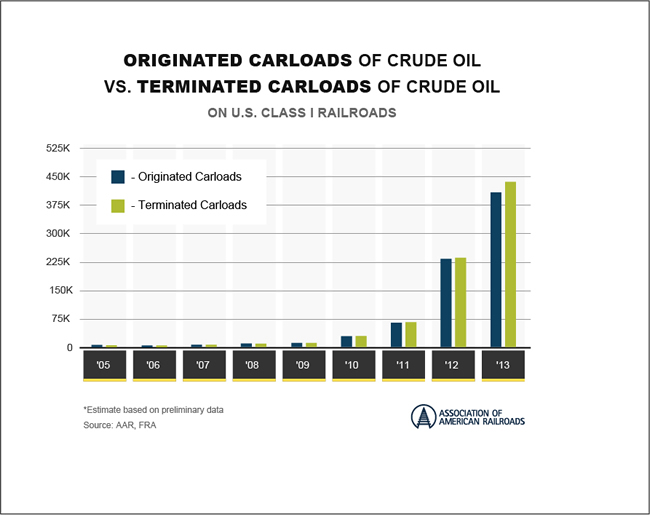
“It was like Christmas here,” says Foster Sayers, general counsel and government liaison for Vertex, of the release of the final rule two weeks earlier than company leaders had thought. Moreover, he says, “The timeline established for the phasing out and retrofitting of the existing tank cars was as aggressive as we could have hoped for.”
“We could not have written it better,” says Vertex Rail CEO Don Croteau. “It’s a significant change to the current status. My opinion is that many of those cars will be unable to be retrofitted,” meaning more potential business for Vertex. The major railcar manufacturers already face a two-year backlog of orders. Croteau says even without a factory, his fledgling company in the past 18 months has quoted $5 billion and 33,000 railcars worth of business.
Some in the industry had been pushing for a period of five or 10 years for the new standards to take effect. But accidents have a way of bumping up timetables. The new rule stipulates that DOT111 cars will be phased out by the end of 2017.
“They all have to be off the rails or retrofitted,” says Sayers. “That’s 140,000 cars impacted.” Unjacketed CPC 1232s have to be off the rails or retrofitted by April 1, 2010. No fooling.
“It’s a tremendous undertaking for the industry,” says Sayers, “and we’re obviously very excited because the capacity of the other manufacturers out there is pretty much tied up with just the market demand resulting from the fact we’re transporting 1 million barrels of crude by rail per day in this country.”
Rules of the Rail
“Safety has been our top priority at every step in the process for finalizing this rule, which is a significant improvement over the current regulations and requirements and will make transporting flammable liquids safer,” said Secretary Foxx on May 1. “Our close collaboration with Canada on new tank car standards is recognition that the trains moving unprecedented amounts of crude by rail are not US or Canadian tank cars — they are part of a North American fleet and a shared safety challenge.”
“This stronger, safer, more robust tank car will protect communities on both sides of our shared border,” said Minister Raitt. “Through strong collaboration we have developed a harmonized solution for North America’s tank car fleet. I am hopeful that this kind of cooperation will be a model for future Canada-US partnership on transportation issues.”
There has been a 4,000-percent increase in the transport of crude by rail since 2008.
The final rule represents the latest, and most significant to date, in a series of nearly 30 actions that DOT has initiated over the last 19 months, including additional emergency orders, safety advisories and other actions. Unless stated otherwise, the rule applies to “high-hazard flammable trains” (HHFTs) — a continuous block of 20 or more tank cars loaded with a flammable liquid or 35 or more tank cars loaded with a flammable liquid that are dispersed through a train. Other aspects of the rule address routing of trains, and offer a choice between a 30-mph speed limit or new ECP braking systems that will be required on a single train with 70 or more tank cars loaded with Class 3 flammable liquids by 2023, something which drew the ire of the American Association of Railroads.
“The DOT couldn’t make a safety case for ECP but forged ahead anyhow,” said Edward R. Hamberger, AAR president and CEO, calling these aspects of the rule “rash” and “imprudent.”
“This decision not only threatens the operational management of the U.S. rail system, but trains moving 30 mph will compromise network capacity by at least 30 percent,” he said. “The far-reaching effects of this decision will be felt by freight and passenger customers alike. Slow-moving trains will back up the entire rail system.”
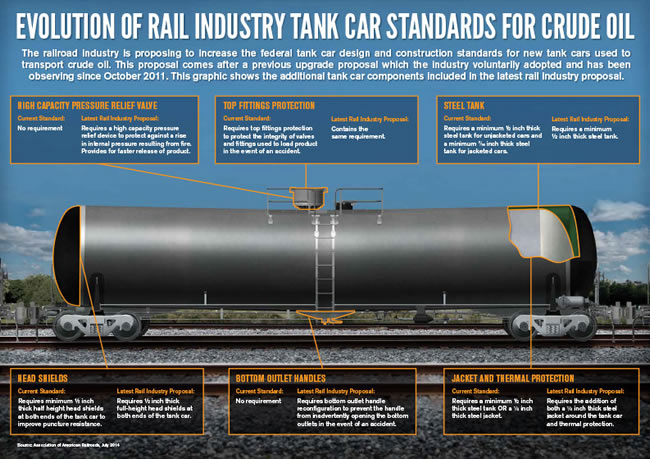
All the new guidelines are needed to address shipping of crude by rail, which has increased by a factor of 50 in the last five years. There has been a 4,000-percent increase in the transport of crude by rail since 2008, with over 500,000 carloads of crude shipped in 2014.
Nationwide Search
Analysis by Dr. William “Woody” Hall, senior economist at the University of North Carolina Wilmington’s Cameron School of Business, says Vertex’s operations will ultimately spur $1.1 billion in annual economic impact across four counties.
“When you combine the market demand with the impact of the regulations and then the fact we are bringing the new capacity online, it’s the perfect storm, so to speak,” says Foster Sayers. “We were gearing up for everything regardless … it takes a lot to spin up an operation of this size.”
Sayers says the state government and North Carolina DOT “have been very helpful in getting us improved road access to the site and rail access. Obviously we’ll be shipping a large volume of cars, so we need to upgrade the rail crossing and line that goes by the port here.” The state is contributing $450,000 to that effort, and along with short-line rail operator Genesee & Wyoming will upgrade the rail access to the site. A second access point for the site will be created, with the DOT paying for a portion of the cost and the city and New Hanover County each contributing $300,000.
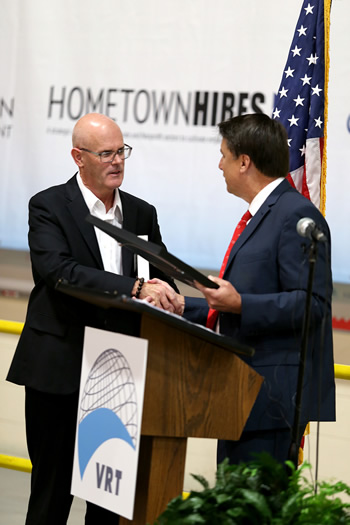
Croteau says the search began in fall 2013, led by the need for a facility at least 1,000 ft. in length and large height and width dimensions as well, plus rail access, preferably on property. Candidate facilities were evaluated in Pennsylvania, Alabama, Georgia, South Carolina, Colorado, California, Michigan and Texas. A number of them were in significant disrepair. But Wilmington’s wasn’t.
Moreover, Croteau knew Wilmington from his years of experience making industrial tanks for clients such as GE Hitachi Nuclear Energy, which has a major presence there, as well as other clients. So the area had the inside line from the beginning. He says Wilmington Business Development CEO Scott Satterfield and Director of Business Development Billy King were “spectacular” in assisting the search since their first contact in February 2014, when Croteau and his team were just starting to wrestle with how to staff their planned operation.
“They understood the confidential aspect, and immediately began bringing in capable and wonderful people to help the process,” he says.
Transport solutions to accommodate 1,300 workers were high on the punch list after the company’s job fair in December. It was scheduled to begin at 10 a.m., but people ended up getting in a bit earlier.
“The sheriff said we had to let people in because traffic was backed up for two and a half miles,” says Sayers. More than 10,000 applications were turned in, “which is a stunning number,” says Croteau. “It shows people are either underemployed or unemployed.”
Meaningful Work
Terex shuttered production in Wilmington in 2011 due to a drop in global demand for cranes in the wake of the recession, idling 90 workers and leaving vacant over 550,000 sq. ft. of assembly, fabrication and warehouse space. Croteau points out that at its height of production, however, the Terex facility employed more than 500 workers, including a lot of welding and fitting talent. He says several ex-Terex people have applied at Vertex.
Vertex’s “A team” of welders and other hires, about 40 in all, will start on site next week. Cape Fear Community College is performing the training at no cost to Vertex. Another crucial tool is Hometown Hires, a program created by New Hanover County District Attorney Ben David and operated by the United Way of the Cape Fear Area that connects jobless residents of Brunswick, New Hanover and Pender counties with employment and career-development support. Part of the program works to transition people with criminal records to gainful employment without having their applications summarily dismissed because of checking that box.
It’s a part of Vertex’s mission that Vertex CEO Don Croteau considers very important, in part because of his own family’s time on welfare in his home territory back in Massachusetts. Vertex has committed to hiring at least 10 percent of its workers from such disadvantaged communities, in order to help those looking to support their families with decent wages and benefits break the cycle of intergenerational poverty. He says of the program’s founding by the district attorney, “You’d think he would just be interested in putting people in jail. But he also knew if you didn’t break this poverty cycle, you’d just keep putting people in jail forever.”
He says the Hometown Hires program fits perfectly with Vertex’s own mission go “be good and do good.”
“I feel it’s important to pay people well,” he says. “They’ll work hard, and we’ll all benefit.”
Do the Right Thing
Even as he reached out to the disadvantaged, Croteau also avoided taking advantage when it came to project incentives.
“I won’t say we didn’t want them,” he says. “We had not been through anything like this. We didn’t know we should ask.”
A few large offers later, he knew better. But at the same time he and his team had done their research on their favored site in Wilmington. They had talked to the governor and the DOT, “and everyone had made great presentations and made me feel this was the place to be,” he says. But when they proceeded to talk incentives, “I had to pretend we weren’t coming,” he says, because of policies that only kick in if serious alternative sites are in the running.
“The way you get them is you tell someone you’re thinking of going somewhere else. I thought it strange on an emotional level,” says Croteau. “And when they talked about what they might be able to give us, it was such a small amount compared to what the top line revenue should be in the next 18 months to two years, I felt it was unnecessary to abuse the system, and it could be spent on something far more deserving. Pretending to want even more money was counterintuitive to my mind and my heart.”
It wasn’t counterintuitive to his financial colleagues, he says, who thought he was crazy. But the capital from the gesture has only just begun to roll in.
“It was the best decision I ever made, because since then, everyone has quietly said, ‘We’ll support them like they supported us.’ We probably have reaped maybe 20 times the financial benefit” the company would have realized after tussling over incentives, with none of the emotional fallout that such a battle might have engendered, and emotional ballast instead.
“I’m here to tell you that if you say no to the small stuff and yes to the relationship, you may win out,” Croteau says. “Saying no to incremental incentives has reaped significant benefits politically and personally and professionally. It was the right thing to do from the beginning, and I haven’t regretted it.”
Now comes the battle of competition, with such longstanding stalwarts as Trinity Industries, Union Tank Car and National Steel in Canada. Croteau compliments those companies’ skills and decades of experience. “The problem is they have a significant backlog,” he says. If you need an oil tank car and don’t already have an order in, it’s a two-year wait some companies can’t afford to undergo.
He says the $5 billion worth of quotes by his sales team “tells you the market is interested and excited. We can build the cars for anybody. I would be very happy if I had my own two-year backlog in six months. But for now we have that clean slate, and they’re really not going to have any place to go but to us.”
So is one plant going to be enough?
“It may not be enough,” he says. But there’s room on Vertex’s 68 acres to double capacity. “We have talked about that already publicly. We would like to be in Wilmington, and would like to consider doubling the space in two to three years, depending on the market and the appetites of the community, in terms of logistics and site and people. We’d love to double it, and this would be the first place we’d look.”
But first it’s the place to get to work.
“We’re ready to build lots of cars and make money,” says Croteau. “That’s our job.”
